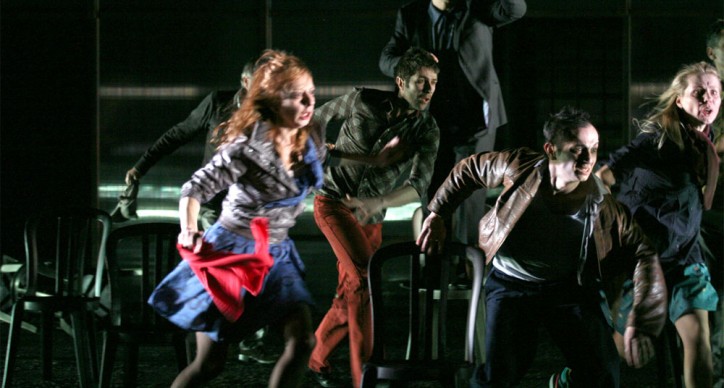Rhinocéros by Eugène Ionesco, a man among his ex-peers
Editor’s Note: Théâtre de la Ville perform Rhinocéros, a seminal theater of the absurd play, this October.
Sometimes, absurdity makes much sense.
In a peaceful village somewhere in France, a cat is being run over by a rhino. The rhino is a special one: not a wild, exotic animal escaped from a zoo, but some sort of a “human-rhino,” a human being turned into a beast. The political farce at stake in Ionesco’s play Rhinocéros is about the humanity of this inhuman epidemic through which almost everybody converts to the rhino-mania.
Beyond the absurdity of the improvisation of this rhino-circus lies the fable of resistance and conformity, or, to put it into perspective, the resistance to the pressure of conformity. But when everyone hurries to wear the same uniform, this rush to conform can actually trigger a minor, yet heroic counter-transition: from coward and anonymous character to brave and committed humanist. Such is the case of Bérenger, an insignificant employee on the verge of either alcoholism or existential vertigo (maybe both), who comes out as an unexpected résistant when everything around him urges him to become a rhino.
The theater of the absurd is subject to many interpretations, and most commentators have praised this play for its creative critique of the rise of totalitarianism. Some have specifically seen a reference to the Vichy episode (1940-1944), when the majority of French accepted collaboration with Nazi Germany. This massive collaboration was so degrading and disgraceful for the myth of France fighting fascism that, that, once Hitler was defeated, French people rephrased History and reinvented themselves as a nation of résistants during the collaboration – a case of bad consciousness, as would say Sartre.
A more personal interpretation is that Ionesco, as he was living in Romania during the 30s, witnessed the rise of a xenophobic, nationalist and anti-Semitic movement, the Garda de Fier (the Legionary Movement), which repelled him and made him consider France as a land of escape. Ionesco was deeply hurt and confused by the fact that his close friends, Emil Cioran and Mircea Eliade, became enthusiastic about the Legionary Movement. Once they would gather again, this time in Paris after WW2, Cioran and Eliade would hide their embarrassing past and Ionesco would not mention or write explicitly about their former “political fever.” In this perspective, the play Rhinocéros, published in 1959, might be his personal meditation on the loneliness and the legitimacy of the one who resists until the end against all the others, including his friends.
Unfortunately, nowadays, the rhinos depicted by Ionesco are not an endangered species, and Ionesco’s fable about the tensions between resistance and conformity continues to speak to a large audience worldwide.
At some point, if not every day, one finds himself at the crossroad between the temptation to fit the rhino-mania of his times and the interior duty to fight against the normalization of minds and actions. The last sentences “Je suis le dernier homme, je le resterai jusqu’au bout ! Je ne capitule pas !” (“I am the last human, and will remain so until the end. I don’t surrender!”) cannot fail to strike us by its invigorating humanism.







